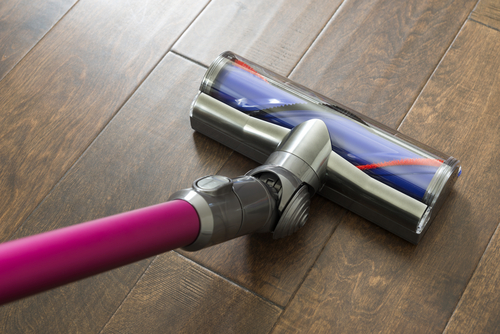Hardwood floors are an investment that, when properly cared for, can endure for generations. It’s not uncommon to see intricate, prewar parquet or turn-of-the-century unfinished hardwood in preserved and historic homes. These 100-plus-year-old examples are exceptional, yes, but they’re still a testament to the enduring potential of a well cared for wood floor.

When you decide to install solid hardwood flooring in your home, you’re making a decision that could bring returns for a century or more into the future. In order to safeguard your investment, you have to learn how to properly care for your wood floors so they perform like new decade after decade. Here’s how to do it, according to the experts at BuildDirect.
How to Maintain Your Hardwood Floors
Many homeowners select traditional, solid hardwood flooring because it’s constructed from thick, pure wood and can be sanded down and refinished many times in a lifetime, so floors always look like new, though beautiful, solid hardwood has a downfall—it hates moisture. Of course, this is something you should always keep in mind during cleaning and maintenance of your hardwood floors, as excess or prolonged moisture exposure could cause irreversible warping, expanding, and cupping.
Have a Routine
- The Routine: Weekly and semi-weekly maintenance is necessary for keeping your hardwood floors beautiful, lustrous, and free of any surface-compromising damage.
- Any hard-surface floor should be regularly broom-swept with a soft-bristled broom and thoroughly vacuumed using a hard floor attachment at least twice a week. Any dirt, dust, or debris that’s allowed to sit on the surface could scratch it, causing permanent damage.
- Mop using a soft, microfiber mop—these mops are gentle enough to prevent surface scratches, thanks to their thousand-plus fibers per inch—at least once a week. The Hardwood Distributors Association (HDA) emphasizes the importance of damp mopping—never saturate your wood floors with water!
- It’s crucial that you never let any moisture sit on the floor to soak in. Address spills and drips immediately using a soft, clean cloth. Towel-dry the area and allow it to dry completely.
- Occasionally, to liven up drab and dull finishes, you’ll want to apply a shine-boosting floor polish. We recommend polishing at least twice a year or more if your home has exceptionally high levels of foot traffic.

Keep Supplies On Hand
- The Supplies: In addition to your trusty microfiber mop, you’ll want to have a no-scratch hardwood vacuum attachment and the right cleaning and protection products.
- You’ll want to select the hardwood floor cleaner that was specifically recommended by your manufacturer, if you know it, to avoid voiding your warranty or damaging your floors. Many flooring manufacturers—including Armstrong, Bruce and others—have their own branded cleaners, while others call out solutions by top brands, such as Bona and WOCA, in their care and maintenance instructions.
- Don’t know who made your floors? Don’t worry! Try to find out the type of finish that was used on your floors and select accordingly. If you still don’t know, select a generic hardwood cleaner. he Bona family of cleaners come highly recommended and are often a safe bet.
- Make sure to protect your floors from scratches, dents, and nicks by placing protective felt pads or covers on the legs of your furniture. It’s also a good idea to place dirt-collecting mats at each entryway and to ask your guests to remove their shoes when they enter your home. Always cover fragile hardwood floors with area rugs and runners in heavily trafficked areas.
What Not to Do
- The No-Nos: We generally recommend avoiding any DIY hardwood cleaners. Never use vinegar and water to clean hardwood, and avoid any wax- or petroleum-based products, unless you know for certain that your floor has a wax finish, as these products will trap in dirt and then scratch the surface of the floor, according to the HDA.
How to Maintain Your Hardwood Floors: Engineered Hardwood Edition
While hardwood may last longer in dry environments due to its ability to be refinished several times, it’s not the ideal choice for wet environments. On the other hand, engineered hardwood floors are more appropriate for high-moisture areas and areas with frequent temperature changes. They feature a layered, mixed-material construction. This makes cleaning a little bit less risky. Still, you should follow the same maintenance tips as the ones above and avoid exposing your engineered hardwood flooring to sitting moisture and you should only dry-mop.

Talk to the Experts
BuildDirect has been in the business of supplying both pros and DIY-ers with low-priced, premium-quality flooring products for 20 years, and we’ve picked up a lot of maintenance knowledge along the way. If you have any questions about the care and maintenance of the products we sell, don’t hesitate to reach out to us.
![[object Object]](https://assets.builddirect.com/images/logo-blue.png?auto=format&fit=max&w=384)


















